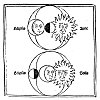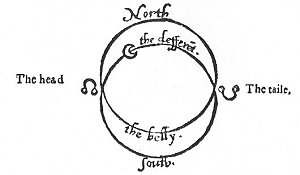
Sacred Texts Earth Mysteries Index Previous Next

The second catastrophe to afflict the Earth in the beginning of things was the Earth-Moon catastrophe; and this, by the way, is not only one of the most ancient of traditions, but it is also a modern theory of causes with which

Click to enlarge
PLATE X. A. The Heavenly Goose.
(From Ancient Mythology: Jacob Bryant, 1774, Vol. II)

Click to enlarge
PLATE X. B. The Sky Goddess Nut represented double.
(From The Dawn of Astronomy; J. Norman Lockyer, 1894)
science has been flirting for half a century. So difficult is it to find anything new, even a new theory, which cannot

Click to enlarge
FIGURE 36. Lunar and Solar Eclipses.
(From Sphæra Mundi; Joannes Sacro Bosco, Venice, 1482.)
be traced back along some old tangled thread of folk-lore. It is difficult, however, to find anything older in man's consciousness than the riddle of the Moon. What is it, that changeless, ever-changing, flat-faced disc in the sky, forever turning about the Earth, yet never turning
its other face to the Earth? What mysterious other-world, under-world, over-world, dead or alive, lies on its secret side? What is the relation of the Moon to the

FIGURE 37. The Figure of the Dragon: the Lunar Nodes.
(From Blundeville His Exercises; London, 1606.)
[paragraph continues] Earth and to man? what the relation of the hidden life of the Earth and of man to the Moon? Tradition had

FIGURE 38. ''When the Moone is betwixt the Sunne and the Earth.''
(From Blundeville His Exercises; London, 1606.)
doubled these two bodies as a pair acted upon by the Sun, long before astronomers had given us the image of Earth-Moon as a beautiful double planet moving among the
stars; long before mathematicians had constructed from the interrelated "pull" of Sun and Moon and Earth the baffling "problem of three bodies," before which many a wise man has fallen.
Here is the ancient story of the genesis of the Moon.
Long after the separation of Heaven and Earth, and while Earth was still in process of being made ready for human life, but before man had been yet created, it chanced that the line of its course in the heavens was crossed by that of a great Comet, and that by some heavenly accident, the two enormous bodies collided. The terrific impact resulted in the cracking of the Earth's hard shell, and a huge fragment--some traditions say two--was torn away as violently as Nut was torn, in the Egyptian myth, from the body of Seb. This fragment of Earth promptly went into space, and became known as the Moon; and ever since that time Earth and Moon, Mother and Daughter, have been following each other through the heavens. As to which is the pursued, which the pursuer, old accounts vary. But there is always the stable myth of Ceres and Proserpina to fall back on.
Very soon after Galileo made the first drawing of the Moon, in 1610, John Wilkins, Lord Bishop of Chester, devised a highly curious little book, entitled The Discovery of a New World in the Moone, or, A Discourse tending to Prove that ’tis probable there may be another habitable World in that Planet. Wilkins bulwarks his "guess" with similar ones of the ancients: "Pythagoreans in general did affirm," he says, "that the Moone also was Terrestrial, and that she was inhabited as this lower World.
[paragraph continues] . . . . To this opinion of Pythagoras did Plato also assent . . . we may read often in him and his followers of an æthera terra and a lunares populi--an Æthereal Earth and Inhabitants in the Moone." As their world is our Moon, so our world is their Moon, he declares, and quotes others

Click to enlarge
FIGURE 39. The first drawing of the Moon, by Galileo, 1610.
(From The Discovery of a World in the Moone; John Wilkins, 1638.)
of antiquity, whose Heavens and Elysian Fields were there, where the air is most quiet and pure. In the frontispiece to his book, he attempts to show just this relation between them. He goes back to the old Greek myth of the Earth, and calls the two Ceres and Proserpina. "By the fable of Ceres," he says, "continually wandering in search of her daughter Proserpina, it meant nothing else but the longing desire of Men, who live upon Ceres, Earth, to

Click to enlarge
PLATE XI.
OMNIA PER IPSUM FACTA SUNT
Matter in motion, figure, rest: adde Grade.
This is the very somme of All God made:
Att first of nought by’s power in six dayes space.
Now nature acts it's part; here after Grace.
(From Bybel Printen; Matthaeus Merian, 1650)

Click to enlarge
FIGURE 40. Frontispiece and Title-page of ''The Discovery of a World in the Moone''; John Wilkins, 1638.
attain a Place in Proserpina, the Moon or Heaven," and he held that "’tis possible for some of our Posterity to find out a Conveyance to this other World; and, if there be inhabitants there, to have Commerce with them."
Buffon seems to have been the first of modern scientists to voice the modern theory of the genesis of the Moon from this then moonless planet. He followed the push of tradition and made a Comet responsible for the split. This was in the eighteenth century. But in 1879, George H. Darwin lifted tradition to the dignity of an hypothetical guess, and suggested, as a part of his theory of Tidal Evolutions, that the Moon was formerly a part of the Earth; that it was originally much nearer the Earth than it is at present, and is now slowly receding from it; that at the time of the separation of the Earth into Earth and Moon, the planet was hardly larger than it is to-day; that it was hot, solid, ellipsoidical, with an interior more or less liquid, revolving on its axis once every four or five hours, its density increasing and its volume diminishing as it cooled; that, as its volume lessened, its speed of rotation increased, until by centrifugal force, the Moon was born, carrying with it, in its flight into Space, three-quarters of the Earth's crust.
A good deal of interesting discussion followed this new type of Darwinian theory, and a number of scientists began to speculate on the precise place of the origin of the Moon, granted that Darwin was right. Of course--and here again tradition guided them--or had at least preceded them--they chose the Pacific Ocean basin that holds apart the scarred coast lines of western North and

Click to enlarge
PLATE XII. THE EARTH AFTER THE EARTH-MOON CATASTROPHE
(Drawn by George D. Swazey for Popular Astronomy, Aug.-Sept., 1907.)
[paragraph continues] South America, and eastern Asia, the East Indies, New Zealand, and the Antarctics. One of these speculators amused himself to good purpose: Plate XII, shows George D. Swazey's extraordinarily imaginative "quarter Earth" which remained after the Moon had flown, cracked by great lines of cleavage that were to slowly split the plastic floating crust into two major continental masses.
Among the old drawings of the Moon, it is difficult to choose--they are all so beautiful. One drawing, however, must always stand for an example of the miracles man has wrought in this quest of his--the first drawing of the Moon (Fig. 39), made in 1610 by Galileo through his "Glasse." That tiny lens, compared to the gigantic telescopes of to-day, amounted to considerably less than a child's toy. But it magnified a surface three times, and with it Galileo essayed to prove or disprove Aristotle's theory that "the form and images of the Ocean appear in the Moon as in a Mirror." "Leaving aside these terrestrial things," he said, "I have directed my researches towards the. heavens, beginning with the Moon." He decided very quickly that the Moon had no mirror-like surface, for he discovered mountains, circular hollows, and many bright spots which he compared to the eyes in a peacock's tail. Before he died, he had succeeded in making a glass which magnified surfaces thirty-two times, and it was not long before the surface of the Moon was mapped out and named. It was a world so similar in many of its formations to those of the Earth, that its first map-maker, Hevelius, simply transferred to the Moon the names of the cities and seas and mountains of the
Earth. But Riccioli, in 1651, renamed its mountains and craters and supposed lakes and seas, not after places of the Earth, but after the learned men of the Earth, choosing rather to place their names in the sky. Instead of lunar Alps or Apennines, there arose on the Moon great mountain ranges, or plains, or craters bearing the names of Plato, Ptolemy, Copernicus, Kepler, Tycho; instead of lunar seas called Caspian, Mediterranean, and the like, there were instead the Seas of Storms, of Clouds, of Rains: the Seas of Tranquillity, of Serenity, and the Lake of Dreams--enchanting names which linger to this day.